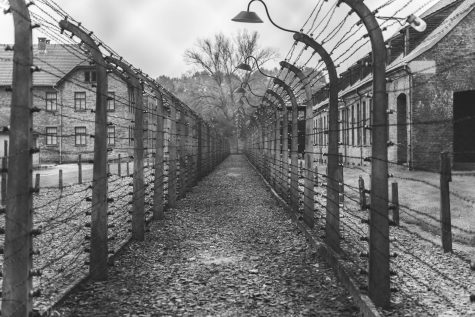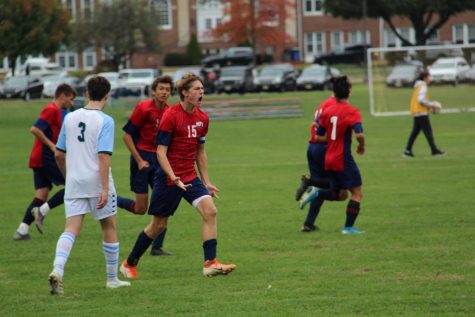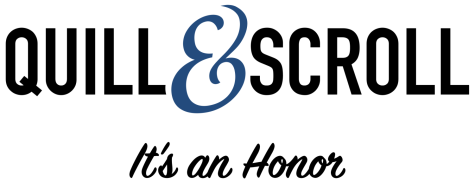THE WEEKLY SCROLL
January 28, 2021
News, tips and advice from Quill and Scroll
The Lede
2021 International Holocaust Remembrance Day
76 years ago, Auschwitz was liberated — We remember through multimedia programs

Photo by Karsten Winegeart on Unsplash
The United Nations established International Holocaust Remembrance Day on the day of liberation of Auschwitz concentration camp in 1945. The international remembrance day was established in 2005 with hopes to, “remind the world of the perspective that the Holocaust provides relevant to preventing future genocides.”
The day has been internationally commemorated on Jan. 27 since 2006; this year, programs all across the world are adapting their ceremonies and remembrances to a virtual format so the day is not forgotten among other issues brought about by the COVID-19 pandemic.
The recognition of the Holocaust in mainstream media is vastly important: according to a 2020 US national survey conducted by the Conference on Jewish Material Claims Against Germany revealed nearly 50 percent of surveyed Generation Z and Millennials had seen posts regarding Holocaust Denial on social media. On top of this, nearly 11 percent of Generation Z and Millennials surveyed believe Jewish persons to be responsible for the Holocaust. Holocaust Denial is considered an act of antisemitism.
The history of Holocaust Denial dates back to the beginning of World War II; Nazi Germany left very little record of their crimes committed against all persons, specifically Jews, on paper or in meeting recordings. Once Germany fell to the Allied powers, Nazi powers worked to destroy any and all evidence left of their crimes against Jewish people — specifically atrocities in Nazi concentration camps.
The United Nation’s Outreach Programme on the Holocaust is vastly important in dispelling conspiracies around the Holocaust and remembering the lives of the six million people murdered during World War II.
While International Holocaust Remembrance Day is officially observed on Jan. 27 every year, we challenge you to look into resources this week that will prepare you, as journalists, to combat Holocaust Denial. For video coverage and multimedia resources gathered by the United States Holocaust Memorial Museum, click here.
You can keep up with international resources on Twitter at #HolocaustRemembranceDay.
New York Times editor fired for a tweet
‘I have chills’ statement results in termination of freelance editor after prior social media cautions

Photo by Jakayla Toney on Unsplash
This weekend The New York Times gained a lot of unwanted attention for supposedly firing a freelance editor that tweeted “in support” of President Biden during his inaugural ceremony.
Lauren Wolfe, a freelance editor for The New York Times representing the “flexible editing desk,” was fired in timing with social fallout over her tweet of an image of CNN coverage of President Biden landing at Joint Base Andrews with the caption, “Biden landing at Joint Andrews now. I have chills.” Twitter was quick to jump to criticism of The Times, assuming the termination was because of Wolfe’s singular tweet.
Prior to Wolfe’s tweet regarding president Biden, Wolfe had made statements about President Trump that verged on “political” according to The Times and other journalists in the field.
To make the situation worse, Wolfe was subsequently followed by Splash News to obtain pictures of Wolfe in a non-professional setting. Now, the situation is not only problematic, but personal.
The situation was trending on Twitter Monday, with Wolfe gaining a lot of personal attention for her current financial situation (Wolfe is now without work amidst the COVID-19 pandemic). The Times has been attacked by Twitter users for “unlawful termination.”
The problem The Times now faces is political – even though that is exactly what they were trying to avoid. According to Joe Pompeo for Vanity Fair, media sources may be relieved to no longer be under fire by the Trump administration for being “fake news,” but also don’t want to be seen as favoring Biden’s democratic administration. Now, The Times appears to be favoring the Trump Administration, if Wolfe’s tweet is taken as a show of support for the Biden era. Either way, it becomes a question of whether objectivity is an integral part of journalism.
National News Literacy Week
News Literacy Project and SCRIPPS host week dedicated to getting ‘NewsLit Fit’
National News Literacy Week is this week, from Jan. 25-29. The goal of the week is to recognize your misunderstanding of news media and improve upon skills you may already have.
The week is hosted by the News Literacy Project and SCRIPPS with support from various partners like The Associated Press, BuzzFeed, The New York Times and other major news publications.
“News literacy is the ability to determine the credibility of news and other content, to identify different types of information, and to use the standards of authoritative, fact-based journalism to determine what to trust, share and act on. Being news-literate also means recognizing the critical role of the First Amendment and a free press in a democracy and interacting with news and other information in ways that promote engaged participation in civic life.”
The week will feature heavy social media interaction on Twitter using the hashtag #NewsLiteracyWeek. Make sure to check out the week’s sponsored tips and tools to build into your journalistic practice.
It’s An Honor
WPM Contest closing soon!
Submit entries in 34 categories for the 2021 Writing, Photo and Multimedia Contest by Feb. 5
 The 2021 Writing, Photo and Multimedia Contest is now open for entries! This year we are offering 34 category contests, including four new categories:
The 2021 Writing, Photo and Multimedia Contest is now open for entries! This year we are offering 34 category contests, including four new categories:
- Climate and Environment Story
- Pandemic Coverage, Single Story
- Pandemic Coverage, Package or Series of Stories
- Sports Event Story
You can view a description of all 34 categories here.
In order to be eligible to submit your work, you must be a high school student and the piece must have been published, broadcast or run by a student media entity or professional news publication between Feb. 1, 2020 and Feb. 1, 2021. Yearbook spreads may be submitted if they fall within those parameters.
For the fourth consecutive year, WPM is completely digital — this means all entries must be accompanied by a link to the entry material that is shareable and viewable for our judges.
To enter, first click on this link to visit the School Entry Form. That form is filled out by someone representing the school or professional organization and can account for payment for entries. Once finished, press “Submit.” The form will automatically redirect you to the Student Entry Form where you will be able to submit entries.
Payment may be made by credit card, check or purchase order. Visit our website to learn more about completing each option.
The final entry deadline is February 5, but it is never too early to send in your entries!
THE SOURCE’ WPM series

Interviews with six Quill and Scroll judges, provide advice for entering contests
Have you been keeping up with our podcast series? This school year, we focused on providing you with the information you need to succeed in our contests as well as improve your journalistic skills. We’ve featured:
- Lyle Muller, former editor of The Cedar Rapids Gazette and current editor for Politifact Iowa
- Jann Nyfeller, music journalist and record shop owner
- Fred Wickman, journalist and former college journalism advisor
- Liz Martin, head photojournalist for The Cedar Rapids Gazette
- Trevor Ivan, Youngstown State University journalism instructor and former contest director for the National Scholastic Press Association
- Erica Hernandez, CNN digital producer and Quill and Scroll advisory board member
- Annie Wooden, The Sanders County Ledger publisher and editor
- Jeff Browne and Judy Hauge, Executive Director and Administrative Assistant for Quill and Scroll
In our latest professional interview, host Sylvia Clubb sits down with editor and publisher Annie Wooden of The Sanders County Ledger in Thompson Falls, MT. In this episode of THE SOURCE, Annie shares with host Sylvia Clubb what she values in news design and what she looks for as a judge for Quill and Scroll’s annual Writing, Photo and Multimedia Contest, the deadline for which is Feb. 5, 2021. She also talks about how her paper’s mission is very similar to the mission of a student newspaper.
Heard a lot about WPM, but not sure where to start? Check out Episode 27 of our podcast, featuring Quill and Scroll Executive Director Jeff Browne and long-time Administrative Assistant Judy Hauge. We discuss the nuts and bolts of WPM: its history, what makes WPM different from other journalism contests and the specifics on entering.
All interviews are focused on improving your writing and photography skills with tips and advice provided by professional and accredited journalists. We still have interviews coming – stay tuned! Until then, make sure you’ve listened to our seven judges!
Quill and Scroll student board establishes online discussion board for student editors
The Quill and Scroll Student Advisory Board is working on a project that will produce a monthly newsletter and a discord chat for editors to use, so they can give and receive help, tips and ideas from other editors.
If you are an editor at a yearbook or news publication or broadcast news entity, sign up on this Google Form to be a part of the discussion. If you’re an adviser, forward it to your editors, be they editors-in-chief, section editors, photo editors or any leader on your staff.
We would like our network to really encompass and connect as many editors as we can. Thank you so much for your time!
Induction season is here
It’s time to honor seniors and induct members
It’s that time of the year when Quill and Scroll chapters should be nudging their advisers to think about honoring seniors and inducting new members — be they sophomores, juniors or seniors — into our international journalism honor society.
We’re able to take and fulfill orders, even as Quill and Scroll staff work from both our home offices and our offices at the Adler Journalism Building on the University of Iowa campus.
We published this update in late 2020. It is still valid and includes a simplified order form for schools and advisers willing to pay via credit card, and an offer to host an online induction ceremony for your students. The sooner you induct new members, the sooner they’ll be able start planning chapter activities in the spirit of Quill and Scroll. Here’s a link to a PDF file of the Q&S Chapter Handbook if you don’t already have it.
A reminder about cords:
Students MUST HAVE BEEN OR WILL BE INDUCTED into the Society to earn the honor to wear an Honor Cord (GHC) or Honor Cord with Insignia (GCI). If you order cords for non-members, please choose the Non-Member Cord Option (NCD). Quill and Scroll exists because of the special unifying bond brought about by membership and the lasting legacy of the induction ceremony.
And, as always, feel free to email [email protected] if you have any questions.
What’s Viral?
New media bias chart released
Ad Fontes Media unveils updated chart for January 2021 based on research
Have you heard of the Media Bias Chart? If you have, you know it’s a reliable data set created to help anyone discern what type of media they’re ingesting and what sources provide more accurate information.
The chart was created by Vanessa Otero with Ad Fontes Media (meaning “the source” in Latin) and constantly undergoes review to ensure the most accurate and up-to-date information is reflected in the chart’s ratings. Ad Fontes conducts reviews using a team of researchers to minimize bias as well as follows a stringent review document to hone in on objective issues.
The chart comes in two forms: a static image and an interactive chart that allows you to focus in on the exact scores for each news source. Check them out!
New year, new Chart! Media Bias Chart 7.0 is here with some new sources, updated scores reflecting changes in the media landscape.
We now have nearly 300 news sources fully rated, most of which you can already see on our Interactive Chart. https://t.co/JhdsmTbsLe pic.twitter.com/AQmK5bEVIq
— Vanessa Otero (@vlotero) January 25, 2021
Reddit users overhaul predicted stock trends to save GameStop
Social chain temporarily saves aging retail business
Familiar with stocks? How about internet trolls? Or even… plots to prove successful businessmen wrong? Ah! That’s the one. Well, the new “prove me wrong” act can be found within the DOW – specifically with the stock GME, or GameStop, and a few small investors connecting through Reddit.
If you’re not familiar with stock talk, here’s the gist of the story: experts and large investors predicted the GameStop stock would crash soon because of its continued decrease in business. No business = no investors. Anyone can make “bets” on the future of a stock: if someone predicts a stock will crash, and it does, they gain money.
Two large investment firms placed big bets on GameStop crashing. And what happens? Smaller, individual investors connected through Reddit to invest enough money into GameStop to drive the stock price from $18 to $380 – essentially overnight.
TD Ameritrade said it was restricting trading for GameStop, AMC and others amid a triple-digit percentage surge in the value of those companies in recent days. $GME $AMC https://t.co/rT1NDaqncT pic.twitter.com/Oo402DMexE
— MarketWatch (@MarketWatch) January 27, 2021
So, what’s the motive?
As far as anyone can tell, small investors just wanted to defeat large investment firms in what’s been labeled a “battle.” Now, investors have turned toward another company’s falling stock: AMC Theatres. #SaveAMC began trending on Twitter Wednesday.
Want to follow along on Reddit with the defeat of large investment companies? Visit the Reddit thread here.
Where’s Bernie?

Photo by Vidar Nordli-Mathisen on Unsplash
Inauguration meme goes viral, Vermont senator donates profits to charity
You may recognize the name Bernie Sanders from the 2016 and 2020 presidential elections – a stark independent candidate that often resonates with Generation Z because of his focus on free higher education, the middle class and climate change. Sanders attended President Biden’s inauguration, and in turn, became an international meme (for the second time).
The Presidential Inauguration is always held in January (barring any complications) on the grounds of the capitol in Washington D.C. Many forget that often, northeastern weather is not cooperative for this event and leaves guests chilled to the bone. So, Senator Sanders came appropriately dressed to view an hour-long outside ceremony.
The picture of Sanders bundled up quickly circulated through Twitter, becoming a viral meme. Check out this post for a pretty creative use of bundled Bernie.
Bernie looking like “this could’ve been an email.” pic.twitter.com/Dacef6o7PE
— s•b (@H3YLiGHTSKiN) January 20, 2021
The internet really can be magical pic.twitter.com/Jrwkj2twii
— Ashley Holub, PhD (@ashtroid22) January 21, 2021
The best part of the viral image is its cause: once Sanders’ team realized the demand and appreciation for the image, they slapped it on a sweatshirt and are donating all proceeds to the Vermont Meals on Wheels program.
The sweatshirt is sold out for the next eight weeks.
Just A Thought
Student journalists deserve legal protections against censoring
‘The 74’ opinion column by Katina Paron
We’ve talked a lot here at Quill and Scroll about student journalists rights and protections as well as “New Voices” laws that reverse the ruling of Hazelwood v. Kuhlmeier, which opened the door for public school systems to censor the work of student journalists within their school publications. Yet, to this day, students across the country and world remain unprotected from censoring that limits their ability to cover topics to the same extent as professional journalists.
We recently covered the work of Quill and Scroll charter school Dupont Manual HS in Louisville, Kentucky in exposing training tools of Kentucky police departments that referred to quotes by Adolf Hitler and Confederate General Robert Lee. This is just one example of the impact student journalists have in their own communities. Yet, stories like this are dangerous for students to publish: they risk censorship and even expulsion from public schools if they publish works that don’t have the go ahead from school officials.
In the opinion article, “Student Reporters Could be the Fix Local News Needs. Let’s Give Them the Legal Protections to Cover More than Pep Rallies and STEM Competitions,” Katina Paron, the author of “A NewsHound’s Guide to Student Journalism,” explores the problems students face and the problems students could solve within news coverage if given the protections they need. She writes:
“For so long administrators told us students were too immature to handle press freedoms. They said it would be the Wild West if teens could publish whatever they want. Here’s the thing: students are doing that anyway — on their blogs, on social media, in chat forums. But student journalists are not doing that. They are guided by advisers who hold them accountable to the Society of Professional Journalists Code of Ethics — the same code followed by journalists at The Wall Street Journal, The Associated Press, Chicago Tribune, LA Times and every other professional newsroom in the country. Yes, student journalists make mistakes, but so do the pros.”
Now, ask yourselves: what makes your students different than professionals? Is it age? Is it experience? The ability to cover news and cover news well is not defined by age, education level or experience. Good news coverage is accurate and tells the truth in a manner that informs and entertains its audience. Something that, often, students do better than adults. It’s important to recognize and champion the values of student journalism as they become the professionals of tomorrow.
Here at Quill and Scroll, we’re committed to supporting student journalists in uncovering the truth. We have adopted the SPJ Code of Ethics as a complement to our eight guiding principles. Scholastic journalism is not only housed in schools; we are all learners – and we’re all covering important topics. Fighting for the rights of students in covering an event at the same level as a professional is just as necessary as fighting for the rights of the press to be involved in current events.
Ask yourself: how can you help your student journalists?
Read the entire article here.
